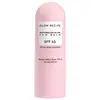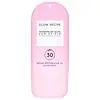What's inside
What's inside
 Key Ingredients
Key Ingredients

 Benefits
Benefits

 Concerns
Concerns

 Ingredients Side-by-side
Ingredients Side-by-side

Butyl Methoxydibenzoylmethane 3%
UV AbsorberHomosalate 5%
Skin ConditioningEthylhexyl Salicylate 5%
UV AbsorberNeopentyl Glycol Dicaprylate/Dicaprate
EmollientOctyldodecanol
EmollientC15-19 Alkane
SolventCoco-Caprylate/Caprate
EmollientSilica Silylate
EmollientButyloctyl Salicylate
Skin ConditioningPolyester-8
Skin ConditioningDibutyl Lauroyl Glutamide
Skin ConditioningSqualane
EmollientCapryloyl Glycerin/Sebacic Acid Copolymer
Skin ConditioningDibutyl Ethylhexanoyl Glutamide
Skin ConditioningVp/Eicosene Copolymer
Tocopheryl Acetate
AntioxidantCitrullus Lanatus Seed Oil
EmollientParfum
MaskingPentaerythrityl Tetra-Di-T-Butyl Hydroxyhydrocinnamate
AntioxidantTetrahexyldecyl Ascorbate
AntioxidantCaprylic/Capric Triglyceride
MaskingLimnanthes Alba Seed Oil
Skin ConditioningGlyceryl Behenate
EmollientSodium Hyaluronate
HumectantNiacinamide
SmoothingCrithmum Maritimum Extract
Skin ConditioningButyl Methoxydibenzoylmethane 3%, Homosalate 5%, Ethylhexyl Salicylate 5%, Neopentyl Glycol Dicaprylate/Dicaprate, Octyldodecanol, C15-19 Alkane, Coco-Caprylate/Caprate, Silica Silylate, Butyloctyl Salicylate, Polyester-8, Dibutyl Lauroyl Glutamide, Squalane, Capryloyl Glycerin/Sebacic Acid Copolymer, Dibutyl Ethylhexanoyl Glutamide, Vp/Eicosene Copolymer, Tocopheryl Acetate, Citrullus Lanatus Seed Oil, Parfum, Pentaerythrityl Tetra-Di-T-Butyl Hydroxyhydrocinnamate, Tetrahexyldecyl Ascorbate, Caprylic/Capric Triglyceride, Limnanthes Alba Seed Oil, Glyceryl Behenate, Sodium Hyaluronate, Niacinamide, Crithmum Maritimum Extract
Butyl Methoxydibenzoylmethane 3%
UV AbsorberHomosalate 7%
Skin ConditioningEthylhexyl Salicylate 5%
UV AbsorberWater
Skin ConditioningButyloctyl Salicylate
Skin ConditioningDiisopropyl Adipate
EmollientOleyl Erucate
EmollientNiacinamide
SmoothingGlycerin
HumectantCetearyl Alcohol
EmollientDiheptyl Succinate
EmollientAmmonium Polyacryloyldimethyl Taurate
Emulsion StabilisingPhenoxyethanol
PreservativeCoco-Glucoside
CleansingCapryloyl Glycerin/Sebacic Acid Copolymer
Skin ConditioningGlycine Soja Oil
EmollientXylitylglucoside
HumectantHydroxyacetophenone
AntioxidantTocopherol
AntioxidantAnhydroxylitol
HumectantParfum
MaskingCitrullus Lanatus Seed Oil
EmollientPongamia Pinnata Seed Extract
Skin ConditioningPolyglyceryl-3 Diisostearate
EmulsifyingXylitol
HumectantEthylhexylglycerin
Skin ConditioningHyaluronic Acid
HumectantOryza Sativa Extract
AbsorbentOryza Sativa Germ Extract
EmollientSodium Phytate
Glucose
HumectantHydrogenated Palm Glycerides Citrate
EmollientButyl Methoxydibenzoylmethane 3%, Homosalate 7%, Ethylhexyl Salicylate 5%, Water, Butyloctyl Salicylate, Diisopropyl Adipate, Oleyl Erucate, Niacinamide, Glycerin, Cetearyl Alcohol, Diheptyl Succinate, Ammonium Polyacryloyldimethyl Taurate, Phenoxyethanol, Coco-Glucoside, Capryloyl Glycerin/Sebacic Acid Copolymer, Glycine Soja Oil, Xylitylglucoside, Hydroxyacetophenone, Tocopherol, Anhydroxylitol, Parfum, Citrullus Lanatus Seed Oil, Pongamia Pinnata Seed Extract, Polyglyceryl-3 Diisostearate, Xylitol, Ethylhexylglycerin, Hyaluronic Acid, Oryza Sativa Extract, Oryza Sativa Germ Extract, Sodium Phytate, Glucose, Hydrogenated Palm Glycerides Citrate
Ingredients Explained
These ingredients are found in both products.
Ingredients higher up in an ingredient list are typically present in a larger amount.
Also known as Avobenzone, this ingredient is a chemical sunscreen filter that provides protection in the UV-A range.
Avobenzone is globally approved and is the most commonly used UV-A filter in the world.
Studies have found that avobenzone becomes ineffective when exposed to UV light (it is not photostable; meaning that it breaks down in sunlight). Because of this, formulations that include avobenzone will usually contain stabilizers such as octocrylene.
However, some modern formulations (looking at you, EU!) are able to stabilize avobenzone by coating the molecules.
Avobenzone does not protect against the UV-B range, so it's important to check that the sunscreen you're using contains other UV filters that do!
The highest concentration of avobenzone permitted is 3% in the US, and 5% in the EU.
Learn more about Butyl MethoxydibenzoylmethaneButyloctyl Salicylate is a chemical UV filter structurally similar to octisalate. It is a photostabilizer, SPF booster, emollient and solvent. This ingredient helps evenly spread out ingredients.
According to a manufacturer, it is suitable for pairing with micro Titanium Dioxide, Zinc Oxide, and pigments.
Photostabilizers help stabilize UV-filters and prevents them from degrading quickly.
Learn more about Butyloctyl SalicylateWe don't have a description for Capryloyl Glycerin/Sebacic Acid Copolymer yet.
Citrullus Lanatus Seed Oil is made by expressing watermelon seeds. It is a non-fragrant oil with antioxidant and hydrating properties.
Watermelon seed oil contains a high percentage of linoleic acid and other fatty acids. These fatty acids make it a great skin hydrator. This ingredient may not be fungal-acne safe.
Ethylhexyl Salicylate is an organic compound used to block UV rays. It primarily absorbs UVB rays but offers a small amount of UVA protection as well.
Commonly found in sunscreens, Ethylhexyl Salicylate is created from salicylic acid and 2-ethylhexanol. You might know salicylic acid as the effective acne fighter ingredient and BHA.
The ethylhexanol in this ingredient is a fatty alcohol and helps hydrate your skin, similar to oils. It is an emollient, which means it traps moisture into the skin.
According to manufacturers, Ethylhexyl Salicylate absorbs UV wavelength of 295-315 nm, with a peak absorption at 307-310 nm. UVA rays are linked to long term skin damage, such as hyperpigmentation. UVB rays emit more energy and are capable of damaging our DNA. UVB rays cause sunburn.
Learn more about Ethylhexyl SalicylateHomosalate is a chemical sunscreen filter that provides protection in the UV-B range (280nm - 320 nm), with a peak protection at 306 nm. It is internationally approved for use in sunscreens.
Homosalate is not photo-stable, meaning it's strength as a UV filter degrades over time with exposure to the sun. Because of this, it's often used in combination with other chemical sunscreen filters as avobenzone (which protects from the UV-A range). Homosalate also helps act as a solvent for harder-to-dissolve UV filters.
(Part of the reason that sunscreens need to be frequently re-applied is due to the photo instability of many chemical sunscreen filters)
Currently, homosalate is approved in concentrations up to 10% in the EU and 15% in the US. The FDA is currently doing further research on the effects of homosalate, and it is possible that these approved concentrations will change in the future.
Learn more about HomosalateNiacinamide is a multitasking form of vitamin B3 that strengthens the skin barrier, reduces pores and dark spots, regulates oil, and improves signs of aging.
And the best part? It's gentle and well-tolerated by most skin types, including sensitive and reactive skin.
You might have heard of "niacin flush", or the reddening of skin that causes itchiness. Niacinamide has not been found to cause this.
In very rare cases, some individuals may not be able to tolerate niacinamide at all or experience an allergic reaction to it.
If you are experiencing flaking, irritation, and dryness with this ingredient, be sure to double check all your products as this ingredient can be found in all categories of skincare.
When incorporating niacinamide into your routine, look out for concentration amounts. Typically, 5% niacinamide provides benefits such as fading dark spots. However, if you have sensitive skin, it is better to begin with a smaller concentration.
When you apply niacinamide to your skin, your body converts it into nicotinamide adenine dinucleotide (NAD). NAD is an essential coenzyme that is already found in your cells as "fuel" and powers countless biological processes.
In your skin, NAD helps repair cell damage, produce new healthy cells, support collagen production, strengthen the skin barrier, and fight environmental stressors (like UV and pollution).
Our natural NAD levels start to decline with age, leading to slower skin repair, visible aging, and a weaker skin barrier. By providing your skin niacinamide, you're recharging your skin's NAD levels. This leads to stronger, healthier, and younger looking skin.
Another name for vitamin B3 is nicotinamide. This vitamin is water-soluble and our bodies don't store it. We obtain Vitamin B3 from either food or skincare. Meat, fish, wheat, yeast, and leafy greens contain vitamin B3.
The type of niacinamide used in skincare is synthetically created.
Learn more about NiacinamideParfum is a catch-all term for an ingredient or more that is used to give a scent to products.
Also called "fragrance", this ingredient can be a blend of hundreds of chemicals or plant oils. This means every product with "fragrance" or "parfum" in the ingredients list is a different mixture.
For instance, Habanolide is a proprietary trade name for a specific aroma chemical. When used as a fragrance ingredient in cosmetics, most aroma chemicals fall under the broad labeling category of “FRAGRANCE” or “PARFUM” according to EU and US regulations.
The term 'parfum' or 'fragrance' is not regulated in many countries. In many cases, it is up to the brand to define this term.
For instance, many brands choose to label themselves as "fragrance-free" because they are not using synthetic fragrances. However, their products may still contain ingredients such as essential oils that are considered a fragrance by INCI standards.
One example is Calendula flower extract. Calendula is an essential oil that still imparts a scent or 'fragrance'.
Depending on the blend, the ingredients in the mixture can cause allergies and sensitivities on the skin. Some ingredients that are known EU allergens include linalool and citronellol.
Parfum can also be used to mask or cover an unpleasant scent.
The bottom line is: not all fragrances/parfum/ingredients are created equally. If you are worried about fragrances, we recommend taking a closer look at an ingredient. And of course, we always recommend speaking with a professional.
Learn more about Parfum